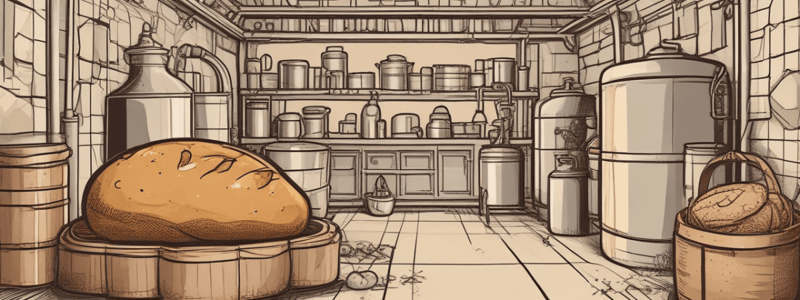Podcast
Questions and Answers
What is the primary challenge in creating a sour culture for bread making?
What is the primary challenge in creating a sour culture for bread making?
What is the primary reason for using a flour mix high in bran for creating a sour starter?
What is the primary reason for using a flour mix high in bran for creating a sour starter?
Why may the initial burst of microbial activity in a grape-based sour starter be short-lived?
Why may the initial burst of microbial activity in a grape-based sour starter be short-lived?
What is the name of a fairly firm sour starter in French?
What is the name of a fairly firm sour starter in French?
Signup and view all the answers
What is the primary advantage of using a flour and water mixture to create a sour starter?
What is the primary advantage of using a flour and water mixture to create a sour starter?
Signup and view all the answers
What is the recommended mixture of flours to create a sour starter?
What is the recommended mixture of flours to create a sour starter?
Signup and view all the answers
Why may buttermilk, potato water, or organic grapes be used as starting points for fermentation?
Why may buttermilk, potato water, or organic grapes be used as starting points for fermentation?
Signup and view all the answers
What is the key to successfully creating a sour starter from a flour and water mixture?
What is the key to successfully creating a sour starter from a flour and water mixture?
Signup and view all the answers
What is the primary advantage of using whole wheat flour in creating a sourdough culture?
What is the primary advantage of using whole wheat flour in creating a sourdough culture?
Signup and view all the answers
What is the purpose of mixing the flours with warm water and holding it at an ambient temperature of 85°F?
What is the purpose of mixing the flours with warm water and holding it at an ambient temperature of 85°F?
Signup and view all the answers
What is the significance of the initial 24-hour period in creating a sourdough culture?
What is the significance of the initial 24-hour period in creating a sourdough culture?
Signup and view all the answers
What is the effect of feeding the culture with white bread flour and less water?
What is the effect of feeding the culture with white bread flour and less water?
Signup and view all the answers
What is the characteristic of the aromas produced by the culture after 10 days of proper maintenance and feeding?
What is the characteristic of the aromas produced by the culture after 10 days of proper maintenance and feeding?
Signup and view all the answers
Why is it beneficial to feed the culture multiple times a day?
Why is it beneficial to feed the culture multiple times a day?
Signup and view all the answers
What is the effect of maintaining a culture at a lower temperature?
What is the effect of maintaining a culture at a lower temperature?
Signup and view all the answers
Why is it risky to maintain a culture at temperatures below 50°F?
Why is it risky to maintain a culture at temperatures below 50°F?
Signup and view all the answers
What is the purpose of feeding the culture at least twice a week at room temperature when refrigerating it?
What is the purpose of feeding the culture at least twice a week at room temperature when refrigerating it?
Signup and view all the answers
How long should the culture be fed twice a day at 70°F before its use in baking?
How long should the culture be fed twice a day at 70°F before its use in baking?
Signup and view all the answers
Study Notes
Creating a Sour Culture for Bread Making
- Fermentation occurs naturally everywhere, and the challenge is to find and isolate the desired microbes.
- Sources like buttermilk, potato water, organic grapes, and outdoor air can be used to create a sour culture, but they may not provide long-term results.
- A sour culture started with grapes will show vigorous fermentation at first, but the yeast may not thrive in a flour and water medium.
- A flour mix high in bran and naturally present fermentable sugars is likely to give good results.
- Using whole wheat flour and medium rye flour is a good starting point, as they are easily available and provide the necessary nutrients for the culture.
Method for Creating a Sour Starter
- Mix whole wheat flour and medium rye flour in a 1:1 ratio with warm water (90°F) to achieve a 90% hydration.
- Hold the mixture at an ambient temperature of 85°F for 24 hours.
- After 24 hours, feed the culture twice a day with white bread flour and less water (60% hydration) and hold it at a lower temperature of 70°F.
Maintaining the Sour Culture
- Feed the culture regularly to promote yeast activity and eliminate unwanted microbes.
- Once-a-day feedings can work, but multiple feedings promote more yeast activity and complexity.
- Maintaining the culture at a lower temperature slows yeast activity and increases acidity.
- Refrigeration can be used to slow down the culture, but it's essential to feed it regularly to maintain viability.
Studying That Suits You
Use AI to generate personalized quizzes and flashcards to suit your learning preferences.
Description
Learn how to create a sour culture for bread making using various sources like buttermilk, potato water, and organic grapes, and understand the challenges of isolating desired microbes for long-term results.




